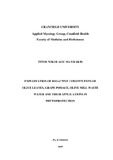JavaScript is disabled for your browser. Some features of this site may not work without it.
| dc.contributor.advisor | Aldred, David | |
| dc.contributor.advisor | Ververidis, Filippos N. | |
| dc.contributor.author | Mavrakis, Titos Nikolaou | |
| dc.date.accessioned | 2010-07-15T09:51:19Z | |
| dc.date.available | 2010-07-15T09:51:19Z | |
| dc.date.issued | 2009-10 | |
| dc.identifier.uri | http://hdl.handle.net/1826/4494 | |
| dc.description.abstract | Pure plants extracts or/and essential oils show antifungal and antibacterial activity against a wide range of fungi and bacteria. Recently there has been increasing interest in the effects of natural compounds against important plant pathogens (fungi and bacteria). Although the antimicrobial activity of oleuropein, grape pomace (GPE) and olive mills waste water (OMWW) extracts have been studied widely, little research has been done on the in vitro and in vivo evaluation of these extracts efficiency against important plant diseases and postharvest treatments. The overall objectives of this study were firstly to extract and isolate from olive leaves (oleuropein), olive mills waste water and from grape pomace (winery by-products) natural compounds in order to be used for in vitro and in vivo experiments. In particular, all three natural extracts were found to restrain in vitro growth of a series of important bacterial and fungal pathogens, such as: Botrytis cinerea, the cause of grey mold disease, Alternaria alternata, causing leaf spots and moulds on several plant species, Fusarium oxysporum fsp melonis, causing Fusarium wilt of melon, a Rhizopus species (a genus causing fruit and vegetable decays), the crucifer pathogen Colletotrichum higginsianum, causing anthracnose leaf spot disease on several Brassica and Raphanus species and Phytophthora parasitica var. nicotianae, the causal agent of the black shank disease of tobacco. Bacterial strains including Clavibacter michiganensis spp. michiganensis, the cause of bacterial canker of tomato, Ralstonia solanacearum causing bacterial wilt in solanaceous plants, Pseudomonas syringae pv. tomato, the cause of bacterial speck on tomato and Arabidopsis and Xanthomonas campestris pv. vesicatoria causing the bacterial spot disease of pepper and tomato were tested. Oleuropein (semipure and pure) showed remarkable antibacterial activity. The minimal inhibitory concentration (MIC), at least of oleuropein was lower than 0.1%. MICs values for GPE and OMWW extract ranged from 0.1% to 0.2%. Moreover, these natural extracts were shown to inhibit and/or restrain spore germination of fungi in solid media, however grape pomace extract, was sufficiently effective to inhibit spore germination and germ tube of C. higginsianum and B. cinerea. Furthermore in vivo antibacterial activity of pure oleuropein and OMWW extract was assessed in greenhouse experiments, on Xanthomonas campestris pv. vesicatoria, the cause of bacterial spot of pepper plants and Pseudomonas syringae pv. tomato, the cause of bacterial speck of tomato plants, respectively. It seems that 0.1% pure oleuropein (98%) and 0.1% OMWW extract had a protective effect against bacterial spot and bacterial speck respectively, which is more obvious when oleuropein application started before infection. Besides endophytic growth of Phytophthora parasitica var. nicotianae, causal agent of the black shank disease of tobacco, on tobacco leaves by measuring its radial growth inside the infected tissue, was assessed. 0.1% GPE showed the most significant inhibition in all tobacco leaves treatments. The potential of postharvest treatment of table grapes with the grape pomace extract (GPE) to restrain grey mould (Botrytis cinerea) disease incidence and development was estimated. 5% GPE treatments produced the strongest inhibitory effect against B. cinerea incidence on grape berries and the time after treatment influenced the numbers of decayed berries. Finally the use of pure oleuropein as antibacterial in vase solution for cut flowers (carnation) was evaluated. Oleuropein showed strong antibacterial activity as vase solution and carnations vase life was more than doubled by using oleuropein 200ppm and 400ppm, compared with control (water). | en_UK |
| dc.language.iso | en | en_UK |
| dc.publisher | Cranfield University | en_UK |
| dc.rights | © Cranfield University, 2009 All rights reserved. No part of this publication may be reproduced without the written permission of the copyright holder. | en_UK |
| dc.title | Exploitation of Bioactive Constituents of Olive Leaves, Grape Pomace, Olive Mills Waste Water and their Application in Phytoprotection | en_UK |
| dc.type | Thesis or dissertation | en_UK |
| dc.type.qualificationlevel | Doctoral | en_UK |
| dc.type.qualificationname | PhD | en_UK |
